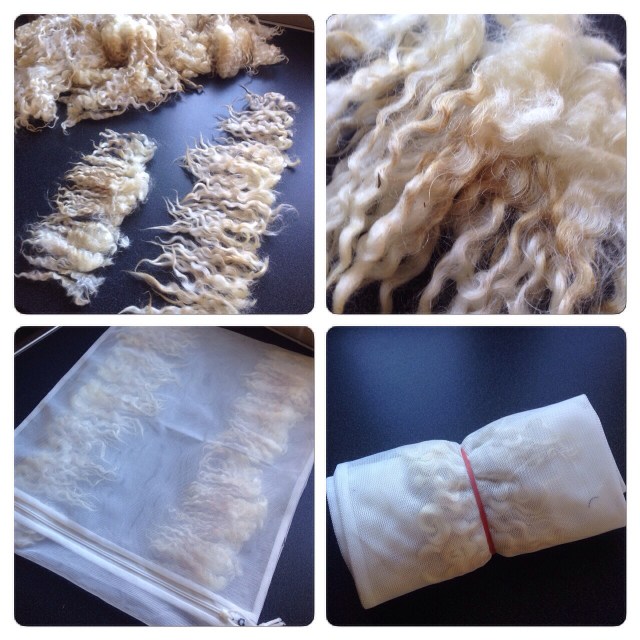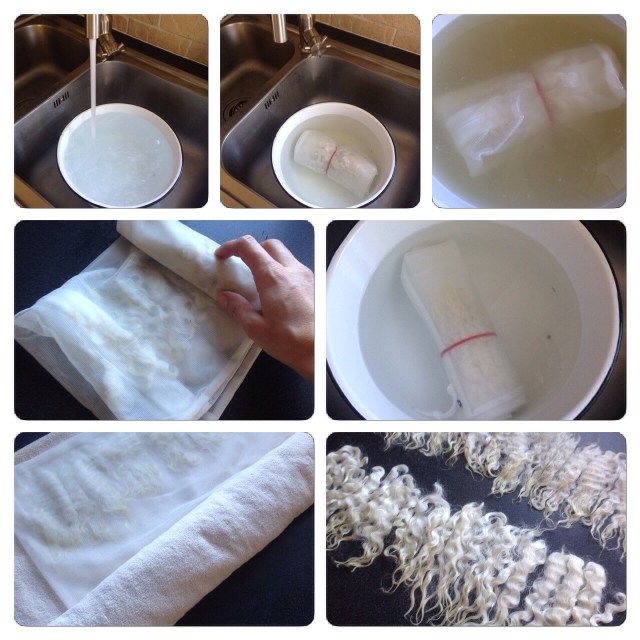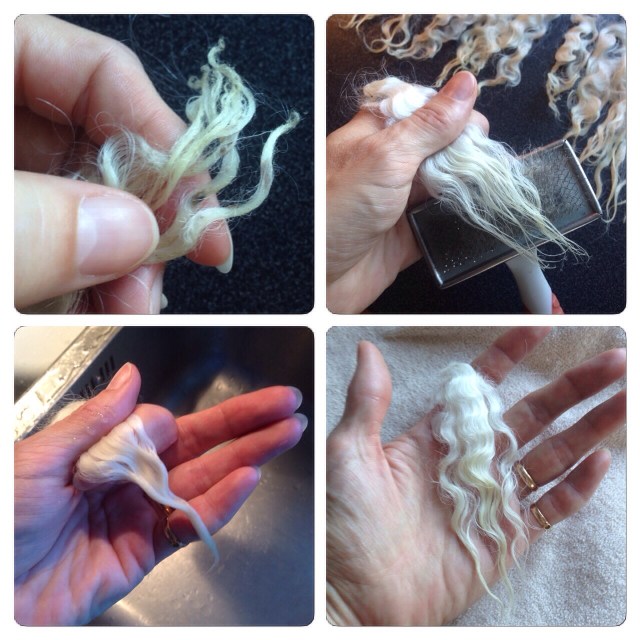Hur man tvättar ull är en återkommande fråga på olika forum på nätet och den frågan får ofta många olika svar och goda råd. Det beror delvis på vilken typ av ull man ska tvätta (t.ex. hur tovningsbenägen den är), men också på vad man ska ha ullen till. Större mängder ull som jag planerar att karda och sedan våttova brukar jag tvätta i nätkorgar i kallt vatten i ett gammalt badkar utomhus (beskrivning av det finns här). Jag vill undvika smuts i kardmaskinen, men ullen behöver inte bli kliniskt ren då den ändå kommer tvättas igen i tovningsprocessen. Om man däremot ska nåltova ullen vill man kanske ha den något mer vältvättad, och om man vill färga ullen behöver man få bort lanolinet för att färgen ska kunna fästa ordentligt.
Sedan har vi de där vackra lockarna som man kanske vill behålla formen på. Jag använder ofta otvättade lockar när jag tovar, och tvättar sedan hela alstret när de är fasttovade. Men ibland vill man nåltova fast lockar på något som är mindre lämpligt att lägga i blöt efteråt, eller så vill man färga lockarna, och då behöver man tvätta dem innan. När jag var på Ull SM (se förra inlägget) köpte jag bland annat vita Leicester lockar, och här tänkte jag visa hur jag har tvättat dem enligt några grundläggande regler för att undvika att de tovar sig.
Regel 1. Ullfibrer som ligger parallellt mot varandra (såsom de växer på fåret) har en mindre tendens att tova sig än när fibrerna korsar varandra. Alltså lägger jag upp mina lockar i rader, och för att minimera risken att de flyttar på sig lägger jag dem så i en tvättpåse som jag viker en gång på mitten (mellan raderna), rullar ihop och fäster med ett gummiband. Då får man ett lätthanterligt knyte att tvätta istället för en massa lösa lockar. I brist på tvättpåse fungerar givetvis ett stycke tyll eller annat nätlikanande tyg av syntet som man kan vika runt lockarna. 
Regel 2. Varmare vatten och tvättmedel ger en effektivare tvätt, men ökar också risken för att ullen tovar sig. Helt logiskt då man använder varmt vatten och såpa/tvål när man våttovar. Värmen och den basiska miljön får fibrernas fjäll att spreta ut sig och då kan fibrerna hak fast i varandra. Så här tänker jag att man kanske kan nöja sig med det ena eller det andra. Antingen varmare vatten ELLER någon typ av tvättmedel (t.ex. ulltvättmedel) i inte fullt så varmt/hett vatten. Man måste upp i över 40-45 °C för att få bort det mesta av lanolinet, och tvättmedel rekommenderas om man ska färga ullen. I det här fallet valde jag bara varmt vatten, det varmaste som gick att få direkt ur kranen.
Regel 3. Bearbetning av ullen under tvätt ökar risken för tovning. Jag fyllde ett kärl med varmt vatten, la ner knytet och lät det sjunka ner och bara ligga där. Motstå frestelsen att röra ullen när den ligger i vattnet! Jag bytte vatten två gånger, efter 30-60 min per bad, tills det sista badet såg rent ut. Vid vattenbyten fiskade jag bara upp knytet, kramade försiktigt ur överskottet vatten, rullade om det åt andra hållet (så att det inte ligger ull i mitten av rullen som blir mindre tvättad) och lät den sjukna ner i nytt vatten. Efter sista badet kramade jag ur överskottet vatten genom att rulla in ullen (fortfarande i tvättpåsen) i en handduk.
Regel 4. Hastiga växlingar i vattentemperatur ökar risken för tovning. När jag bytte vatten försökte jag hålla ungefär samma temperatur på det nya vattnet som det gamla som ullen legat i. Det här är också ett skäl för varför man inte ska låta det ligga för länge i samma bad – vattnet hinner svalna och då får du använda svalare vatten för nästa bad. 
Jag blev rätt nöjd med resultatet, men några lockar hade kvar lite smuts eller såg lite trassliga ut i spetsarna. Det går att borsta ut dem försiktigt, blöta dem igen och krama i en handduk – så länge man håller ett fast grepp om basen på locken inte släpper taget medan man gör det så brukar de återfå sin form. 
Nedan ser ni resultatet. Vackra, vita, glansiga lockar redo att användas som dekor, tomteskägg, änglahår, hästman… eller vad det nu blir. 
Och slutligen några bilder på ull från finullsfår och korsningsfår som jag också tvättade nyligen. Den ska kardas, så då packade jag tvättpåsarna fulla och tvättade dem i enbart ljummet vatten i badkaret (inomhus denna gång, för nu är det minusgrader utomhus). Samma principer som ovan, men utan speciell hänsyn till fiberriktningen. De fick dessutom åka en sväng på kort centrifugering i tvättmaskinen innan jag la dem på tork i trådbackar. Centrifugering i sig är inget problem, men om påsarna kastas runt under tvättmaskinens centifugeringprogram så kan det finnas en viss risk för tovning. Centrifugering kortar dock torktiden väsentligt. 
Ja, mitt bästa råd är att man helt enkelt får prova sig fram till den metod man själv tycker fungerar bäst, beroende på typ av ull och vad man ska använda den till. Men förhoppningsvis kan dessa regler vara ett litet stöd på vägen.
IN ENGLISH
Washing fleece and locks
How to wash fleece is a recurring question on various online forums, and the question often gets many different answers. It partly depends on the type of fleece you are washing (eg how prone it is to felting), but also on what you intend on using it for. Larger quantities of fleece, that I intend to card and use for wet-felting, I usually wash in mesh baskets, in cold water, in an old bathtub outdoors (you can find a description of that here). I want to avoid dirt in my drumcarder, but the fleece doesn´t need to be extremely clean, as it will also be washed again in the felting process. For needle-felting you would perhaps want the fleece to be slightly more well-washed, and if you want to dye the wool you need to remove all the lanolin.
Then we have those beautiful locks, that you might want to keep in their original shape. I often use unwashed locks when I felt, and wash the entire piece when they are felted on. But sometimes you want to needle-felt locks onto something that is less appropriate to soak afterwards, or you want to dye the locks, and then you need to wash them before. I bought some white Leicester locks at the Wool Championships (see previous post), and in this post I thought I could show you how I washed them, following a couple of basic rules to avoid felting.
Rule 1. Fleece fibers lying parallel to each other (as they grow on the sheep) have a lesser tendency to felt than when the fibers cross each other. So, I laid out my locks in rows, and to keep them in place, I placed them like that in a laundry bag, that I folded once in the middle (between the rows), rolled up and secured with a rubber band. That gives you a manageable bundle to wash, instead of a mass of loose locks. In the absence of a laundry bag, you can use a piece of tulle or similar mesh-like synthetic fabric, that can be folded around the locks.
Rule 2. Warmer water and detergent ensures more efficient washing, but also increases the risk of felting. This is quite logical as you use warm water and soap when wet-felting. The heat and the basic (as opposed to acid) environment make the scales on the fibres sprawl out, allowing the fibers to hook into each other. So, here my line of thought is that maybe you can make do with one or the other. Either hot water OR some kind of detergent in not quite so hot water. The water temperature needs to be at least 40-45 °C to remove most of the lanolin, and detergent is recommended if you intend to dye the wool. In this case, I chose only warm/hot water, the warmest I can get directly from the tap.
Rule 3. Any agitation/processing of the fleece during washing, increases the risk of felting. I filled a vessel with hot water, laid down the bundle and let it sink into the water, and just let it lay there. Resist the temptation of moving the fleece around when it is in the water! I changed the water twice, after 30-60 min per bath, until the last bath looked clean. When changing water, I fished up the bundle up, carefully squeezed out the excess water, rolled it the other way (to avoid having the same locks in the middle of the bundle, potentially becoming less washed) and then let it sink into the water again. After the last bath, I squeezed out the excess water by rolling the locks (still in the laundry bag) in a towel.
Rule 4. Sudden changes in water temperature increases the risk of felting. When I changed the water, I tried to use approximately the same temperature in the new water, as the water the locks were in previously. This is also a reason for not leaving the locks for too long in one bath – the water cools down between different baths, and you will end up using cooler and cooler water.
I was quite pleased with the results, but some locks had a little dirt left, or looked a little felted, in the tips. It is possible to brush the tips carefully, wet them again and squeeze them dry in a towel – as long as you keep a firm grip around the base of the locks while doing so, they tend to regain their original shape.
As for the result, I think the photos above speak for themselves. Beautiful, white, shiny locks ready to be used as decoration, a Santa´s beard, hair on an angel, a horses mane … or whatever they will be used for.
And last in this post, some photos of fleece from Finull sheep and cross-breeds, which I also washed recently. This fleece will be carded, so in this case I packed the laundry bags full and washed them in only warm water in the bathtub (indoors this time, because it´s below freezing outside now). The same principles as above, but without special regard to the direction of the fibrers. I also put them through a short spinning cycle in the washing machine, before I put them out to dry in wire baskets. Spinning per se isn’t a problem, but in a front-loaded washing machine there can be a risk of felting if the bags are tossed around too much during the spinning cycle. However, spinning really does reduce the drying time considerably.
My best piece of advice is to simply experiment and try out different methods, until you find one that works well for you, depending on the type of fleece and what you want to use it for. But I hope that these rules may provide some support along the way.

Great tutorial Zara! Washing locks is always tricky, but you make very clear step by step instructions. Thanks for sharing your experience.
Thanks Marilyn! 🙂
I kopied your idea of the wash bag. I washed some Gotland locks, that is very tricky .
It is just as you said,one fleece is not the other.
Thanks for the pics, very useful !
In the end it comes down to trial and error, and learning from that. 😉 But having a basic idea of what makes fleece felt certainly helps. Best of luck with your future washing!
I love your idea of using the laundry bag like that, it seems like it’d be an excellent way to get them washed while keeping them separate. All your photos are gorgeous, and even though I have so many myself, I can’t help but covet them!
The white ones do look better washed, and just imagine what they could look like if you dyed them… 😉
Ha, well since I’ll be getting all my dye stuff out soon, I’m sure there will be some nice colourful locks too 🙂
After you told me about this method, I’ve done it several times. I love it! This approach has worked far better for me than any other technique I tried in the past. Thank you!
I’m so glad to hear that Karen! Best of luck in your continued washing then. 😉